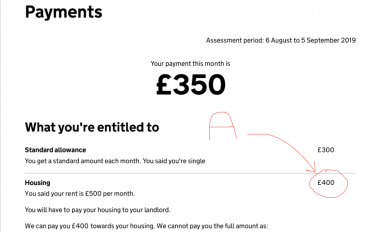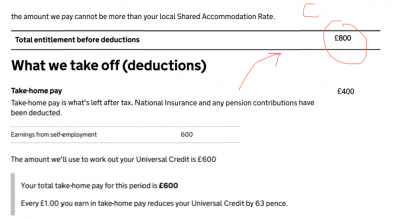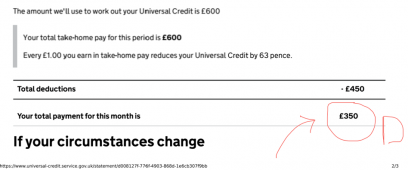Calculating how much rent to apply for when you are on Universal Credit/ Alternative Payment Arrangement.
Blog by Blue Weiss of Flat Justice
When making a Rent Repayment Order (RRO), you can only apply for the rent that you paid: tenants cannot apply for any rent paid by the local authority.
Often the Local Authority only pays part of your rent. In these cases, working out how much rent you are entitled to claim back, and how much the Local Authority is entitled to claim back, is simply put: complicated.
In the Local Authority Guide on this subject there are seven different ‘scenarios’ laid out for those on Universal Credit/ Alternative Payment Arrangement. I have colour coded which scenarios will lead to a situation where it is likely worthwhile for a tenant to apply for rent to be repaid (GREEN), might be worthwhile (ORANGE), or not worthwhile (RED)
|
SCENARIO: |
Conditions: |
Who can apply for rent? |
|
SCENARIO 1: |
–The tenant has no income other than UC
–The tenant is entitled to full rent allowance
–Tenant receives their full UC allowance
|
In this scenario, the Local Authority would get all the rent back from a rent repayment order – no point applying for an RRO1 as a tenant.
|
|
SCENARIO 2: |
–Tenant is entitled to full rent allowance
–UC award reduced by other income
–Net UC award MAY be less than eligible Housing costs
|
In this scenario both the tenant and the Local Authority would be entitled to get rent back. Likely worthwhile for tenant to apply! |
|
SCENARIO 3: |
–Entitlement to housing costs is lower than rental liability
–No income
–Claimants receive maximum UC award, but has a shortfall in housing costs
|
In this scenario the Local Authority would usually be entitled to the majority of rent paid but the tenant could claim some rent back. Might be worthwhile for tenant to apply! |
|
SCENARIO 4 |
–Entitlement to housing costs is lower than rental liability
–UC award reduced by other income
–Net UC award MAY be less than eligible Housing costs
|
In this scenario likely the tenant would get the majority of rent back. Likely worthwhile for tenant to apply! |
|
SCENARIO 5 |
–Alternative Payment Arrangement (APA) in place for full entitlement to housing costs
–APA is shown on the statement
|
In this scenario, the Local Authority would get all the rent back from a rent repayment order – no point applying for an RRO1 as a tenant.
|
|
SCENARIO 6 |
–Alternative Payment Arrangement (APA) in place but is LESS than eligible housing costs
–APA will be up to the full net award
–APA is shown on the statement
|
In this scenario likely the tenant would get the majority of rent back. Likely worthwhile for tenant to apply! |
|
SCENARIO 7 |
–Claimant subject to the benefit cap
–The Universal Credit award is reduced to the level of the cap (20k pa outside London, 23k pa in London)
–The cap is applied to the entire award, so is not apportioned to housing or living costs
–The net amount payable may be lower than eligible housing costs
–If an Alternative Payment Arrangement (APA) is in payment too, the same applies as in SCENARIO 6, whereby the APA can be up to the entire award
|
In this scenario the Local Authority would usually be entitled to the majority of rent paid but the tenant could claim some rent back. Might be worthwhile for tenant to apply! |
In the Local Authority guide, a very convoluted formula is given to calculate what rent the tenant can apply for and what rent the Local Authority can apply to get back.
I will try to explain as best as I can. The formula given in the guide for Local Authorities is the following:
a/c x d = x (y = x – b)
A = Eligible rent
B = Rent Liability
C = Maximum UC award
D = Net UC award
X = Council Owed
Y = Tenant Owed
If that looks like gobbledygook to you, it’s because it partly is; the formula does not make sense.
The formula should be made of two separate parts:
The reason it is B – X, rather than the other way round (as the original formula has it) is that otherwise Y (the amount the tenant gets) would be a minus number!
This as the liable rent (B) will always be more than the amount the Local Authority gets back (X)
Nice try Local Authorities …
However, I know this still looks a bit confusing!
So, I will try and break it down as best I can. First, let me explain what A, B, C, D, X, and Y actually are:
A: Eligible Rent: your entitlement for rent allowance before deductions (confusingly, not the same as what you get)

B: The total amount of rent you have to pay to your landlord
C: The maximum amount of Universal Credit you are entitled to:

D: The amount of Universal Credit you were actually paid:

X = The rent the council could apply to get back if they were applying for a Rent Repayment Order
Y = The rent you can get back if you were to apply for a Rent Repayment Order.
To help explain this further below is an example calculation for a SCENARIO 4 case:
Let’s say, as in the above example:
Rent was: 500pcm
Eligible rent was: 400pcm
Maximum amount of Universal Credit: 800
Net amount of Universal Credit: 350
So the formula is: D x A/C = X & Y = B – X
To put the above in the terms of the formula:
A Eligible Rent: 400
B Liable Rent: 500
C Maximum Universal Credit award: 800
D Net Universal Credit Award: 350
So the calculation would be:
(D) 350 x ((A)400 / (C)800) = 175 (X)
To work out what the tenant gets we need to take ‘X’, which is 175, away from B, which is 500:
500 – 175 = 325 (325 would be ‘Y’ the amount you, the tenant, gets)
Sometimes, rental months and universal credit months do not match up. That is to say you might pay rent on the 1st of every month but receive universal credit on the 6th of every month.
There are lots of very different confusing situations that this problem can arise within. I am not going to confuse you by going through them all!
What I will do is to give a few useful pointers that help in many of these situations:
For example, to calculate one day to be repaid to a tenant in the example at 3:
The formula would stay the same: D x A/C = X & Y = B – X. In fact, we can use the same numbers for ‘A’ and ‘C’.
We just need to amend ‘B’ and ‘D’:
(B) Daily rent: 500 (Monthly rent) x 12 / 365 = 16.438
(D) Daily Universal Credit: 350 (net Universal Credit award) x 12 / 365 = 11.506
So. to calculate the daily amount repaid the calculation would be:
11.506 x (400 / 800) = 5.753 (X)
16.438 (B) – 5.753 = 10.865 (Y)
£10.865 (which we could round to £10.87) is the amount a tenant would get back for one day in that month.